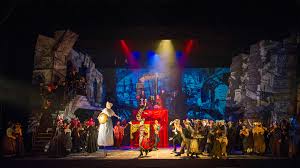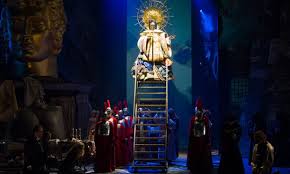London Coliseum, 5 June 2014
Terry Gilliam may be a late starter where opera production is concerned but he has an innate sense of theatricality which supports the heart of the work. He returns to Berlioz after the 2011 production of The Damnation of Faust with a more conventional, though none the less exciting, staging of the rarely-performed Benvenuto Cellini.
The most striking thing about the evening is the sense of focus on the narrative and the clarity of the staging, even when the stage itself is awash with moving sets and extended chorus. Where a number of recent operas which have been reviewed on this site have failed lamentably to integrate a production, allowing the extra activities on stage to dominate and at times wipe out the impact of the music, Terry Gilliam is a master of ensuring we hear and see exactly what is happening. The massed crowd scenes at the end of act one, with various acrobats, dancers, fire-eaters and constant movement, never let us lose sight of Cellini and Teresa. Moreover, when the music becomes more introverted – the long monologue for Cellini in act two – there is never any attempt to up-stage the singer by extraneous activity. We focus on the emotional impact of the internal dialogue, not the external world. It is masterly and could teach many younger directors a great deal about the difference between simply entertaining for the sake of it and staging an opera in an entertaining way by clear focus on the text and score.
The complex settings draw on Piranesi’s prison drawings, and while there is a great deal of movement on stage it never once gets in the way of the music nor draws attention to itself. Even the unveiling of the statue – its vast proportions gloriously over the top – is held back until the narrative has effectively run its course.
At the heart of the evening is Michael Spyres richly convincing Cellini. A real workman who happens to be a great artist, the character seems far closer to Hans Sachs than Don Giovanni – for all the drinking and pseudo-whoring that spin around him. The importance of art and creativity are key elements to the text and Berlioz expounds these even when the scoring is light and rapid. Just because the work has humour in it does not make it a comedy. Again, Terry Gilliam found the balance between the two, allowing the opening scene to drift through the audience with a paper storm from above – echoed in the final moments when we were all showered with golden glitter – but never adding comic elements just for the sake of it.
Corinne Winters was a passionate Teresa, a woman of fire and authority, and as such a real foil to Cellini’s own passion. Nicholas Pallesen made a strong impression as Fieramosca though Pavlo Hunka as Balducci had difficulty carrying across the orchestra.
Willard White may not have the vocal resources he once brought to ENO but his Pope Clement was a gentle caricature, closer to Turandot’s China than the Vatican, and won all hearts.
Edward Gardner handled the vast forces with such sensitivity it would have been easy to take it all for granted, but the balance throughout was exemplary and the choral singing magnificent given the constant movement on stage.
The house was full on the first night and I am sure will be throughout the run. Catch it if you can!


